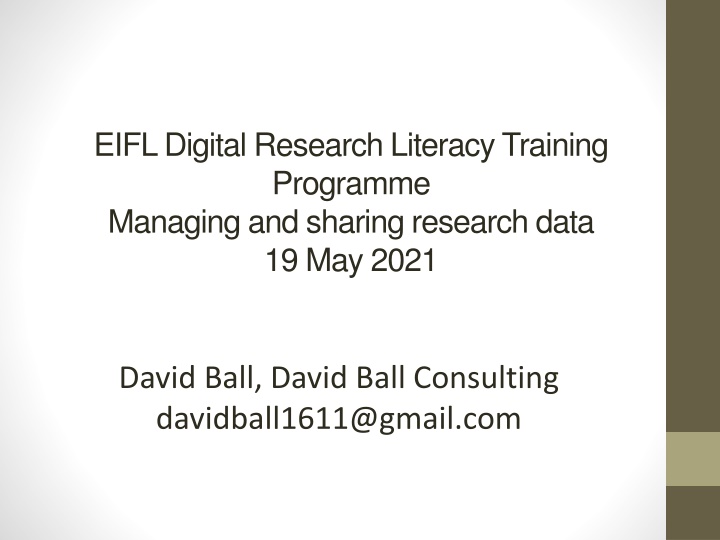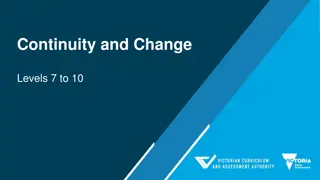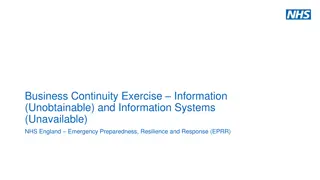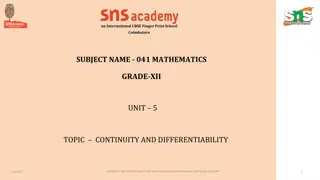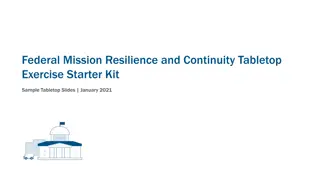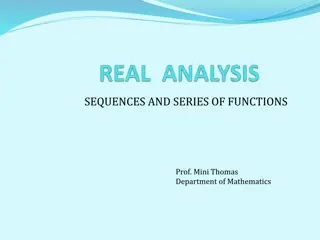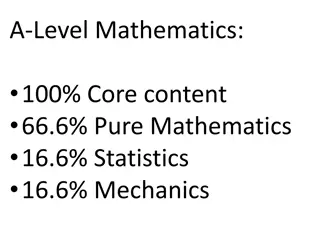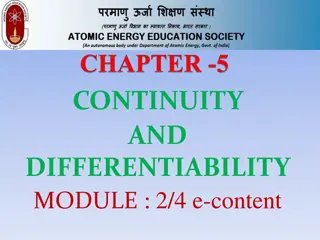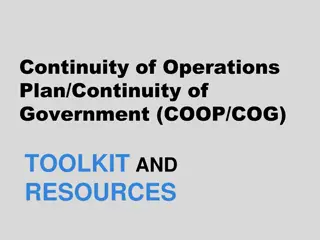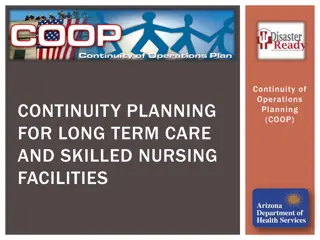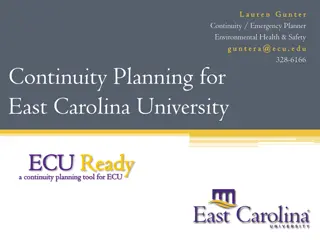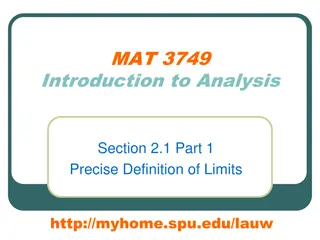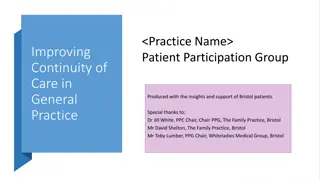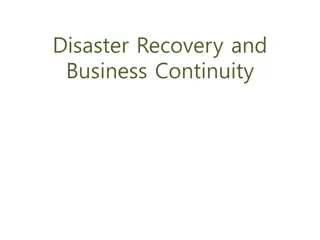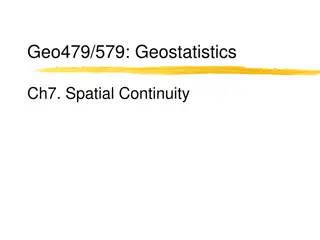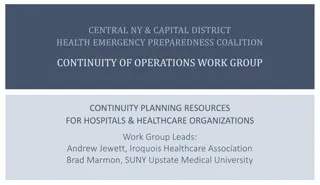Limits and Continuity in Mathematics: Exploring Functions and Calculating Limits
In this insightful guide, delve into the fundamental concepts of limits and continuity in mathematics. Understand how to calculate limits, utilize limit laws, and explore various scenarios involving functions and limits. Gain a comprehensive understanding of one-sided limits, limits at infinity, and more to enhance your mathematical proficiency.
Download Presentation

Please find below an Image/Link to download the presentation.
The content on the website is provided AS IS for your information and personal use only. It may not be sold, licensed, or shared on other websites without obtaining consent from the author.If you encounter any issues during the download, it is possible that the publisher has removed the file from their server.
You are allowed to download the files provided on this website for personal or commercial use, subject to the condition that they are used lawfully. All files are the property of their respective owners.
The content on the website is provided AS IS for your information and personal use only. It may not be sold, licensed, or shared on other websites without obtaining consent from the author.
E N D
Presentation Transcript
EIFL Digital Research Literacy Training Programme Managing and sharing research data 19 May 2021 David Ball, David Ball Consulting davidball1611@gmail.com
This Morning Open Data and its complexities Introducing Open Data Champions The resources provided in the EIFL Training Programme
Open Data: Research Data Definitions Research data can be defined simply as whatever is either produced in research or evidences research outputs. The European Commission s definition is: information, in particular facts or numbers, collected to be examined and considered and as a basis for reasoning, discussion, or calculation (Guidelines on Open Access to Scientific Publications and Research Data in Horizon 2020 - http://ec.europa.eu/research/participants/data/ref/h2020/grants_manual/hi/oa_pilot/ h2020-hi-oa-pilot-guide_en.pdf. Examples include: statistics, results of experiments, measurements, observations resulting from fieldwork, survey results, interview recordings, images. Users can normally access, mine, exploit, reproduce and disseminate openly accessible research data free of charge. CC-BY-NC David Ball 3
Research Data Policies Emerging policies vary, but most will cover the following elements: Timing: when publication should take place Data plan: requirements for a technical management plan Access and Sharing: what exactly will need to be available for public use Long term curation: data creation and sustainability Monitoring: any monitoring that will be carried out by the funding body and guidance available Storage: details of the appropriate repository or data centre to be used Costs: where costs can be claimed from and when CC-BY-NC David Ball 4
Open Data Exemptions As open as possible, as closed as necessary European Commission Exemptions: Incompatible with the obligation to protect results that can reasonably be expected to be commercially or industrially exploited Incompatible with the need for confidentiality in connection with security issues Incompatible with rules on protecting personal data Embargos? CC-BY-NC David Ball 5
Concordat On Open Research Data (UKRI et al.) To ensure that the research data gathered and generated by members of the UK research community is made openly available for use by others wherever possible in a manner consistent with relevant legal, ethical and regulatory frameworks and norms. To establish a set of expectations of good practice with the intention of establishing open research data as the desired position for publicly-funded research over the long-term. https://www.ukri.org/files/legacy/documents/concordatonop enresearchdata-pdf/ CC-BY-NC David Ball 6
Concordat On Open Research Data / 2 Research data are the evidence that underpins the answer to the research question, and can be used to validate findings regardless of its form. They may include, for example, statistics, collections of digital images, sound recordings, transcripts of interviews, survey data and fieldwork observations with appropriate annotations, an interpretation, an artwork, archives, found objects, published texts or a manuscript. CC-BY-NC David Ball 7
FAIR Data Principles (FORCE11) Findable: easy to find the data and the metadata for both humans and computers - persistent identifiers (PIDs); Accessible: data should be retrievable by their identifier using a standardised and open communications protocol; Interoperable: data should be able to be combined with and used with other data or tools. The format of the data should therefore be open and interpretable for various tools; Re-usable: metadata and data should be well described so that they can be replicated and/or combined in different settings (https://www.force11.org/group/fairgroup/fairprinciples) CC-BY-NC David Ball 8
Open Data Champions Champions are a very valuable resource in reaching and convincing researchers in a very practical way: they are existing experienced researchers They have the respect of their research community In 2017 SPARC Europe collected and published the experience of 16 researchers https://openscholarchampions.eu/opendata/champions/ from a variety of disciplines and 7 different European countries. Worth trawling in depth for arguments or examples based on actual research activity The next slides give a flavour of the content.
OD Champions: Rationales Data produced as a result of public funding should be publicly available. It is only possible to validate or reproduce research findings if the underlying data and tools are available. Otherwise they have to be taken on trust. As is now very often the case, independent research groups round the world creating their own data gives rise to inefficiencies. Data can often be re-used, for instance being subject to different methodologies or coupled with other data. Open Data alone makes possible the creation of very large data sets, which can be exploited by machine techniques such as data mining. CC-BY-NC David Ball 10
OD Champions: Actions There needs to be a change in research culture, so that sharing data becomes the norm. This of course depends on the motivation of researchers through academic incentives. Such cultural change may be speeded by gaining the active support of senior researchers and managers. Funders policies can play a very significant role in achieving such change. Open Data (and Open Science) must become an integral part of researchers education, not something separate. It must be made as easy as possible for researchers to deposit and share their data. CC-BY-NC David Ball 11
OD Champions: OD World Knowledge creation will be accelerated, producing real-world benefits, particularly for medicine and business. It should be possible to draw on or incorporate large data sets created outside academia, for instance in transport, meteorology and medicine. The ready availability of data, with appropriate metadata, should drive the development of interdisciplinary research. CC-BY-NC David Ball 12
The Training Programme Content A wide range of formats (videos, courses, guides, practical exercises ) which can be customised For use with different audiences: trainers, library staff, researchers, managers A lot of content within the documents (videos, webinars, articles, presentations ): delve down to find individual relevant elements, such as individual graphs, tables Creative Commons licences https://eifl.net/resources/eifl-digital-research- literacy-training-programme-outline-librarians
Highlights - 1 All the materials referenced are excellent and rich in content; the following are selected highlights, given the time available this morning. URLs are given in the course outline. There are 5 short courses produced by the EU- funded Foster project; they are pretty comprehensive, and can be followed as an accredited course: https://www.fosteropenscience.eu/toolkit There is also a 5-week course created by the University of Edinburgh, which is also of a high standard and accredited: https://www.futurelearn.com/courses/delivering- research-data-management-services
Highlights - 2 About 20 examples of practical tips, guides etc. from several institutions such as OpenAIRE, for direct usage or inspiration: https://www.openaire.eu/guides A comprehensive book, available as a PDF, Engaging Researchers with Data Management: The Cookbook, by respected contributors: https://www.openbookpublishers.com/pro duct/1080
Embedding Open Science Use of the documents assembled is key to winning hearts and minds within institutions, but Open Science needs to be embedded: In academic and research policies, with the committed backing of senior management. In decisions on researchers appraisal and progression only papers deposited in the institutional repository count for progression. In the research and academic committees of the institution In the involvement of champions internal and external. In workflows of researchers, supported by library staff. Open Science must no longer be something new and external.
